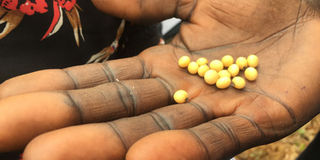Prime
Researchers ‘test drive’ new soy bean varieties

Soy beans. Researchers from different parts of the country have evaluated new varieties of the crop. PHOTO BY CHRISTINE KASEMIIRE
What you need to know:
- The varieties have oil content as high as 20 per cent or more and protein content as high as 40 per cent.
- The college is testing multiple commercial varieties.
- Some of the varieties are inborn while others are fetched from Zambia and South Africa among others.
Researchers from the centre for soy bean improvement and development at Makerere University have tested new varieties of soy bean.
In a three day excursion around different parts of the country, the stakeholders evaluated new varieties of the crop.
Brown, green, black and firm on the ground were some of the properties.
According to Mr Phinehas Tukamuhabwa, professor plant breeding and genetics at Makerere University, the college develops varieties that are resistant to diseases, drought and easy to harvest.
“We also need varieties that are early maturing so that farmers can harvest soon and escape problems of drought. We also have those that are high yielding so the farmer can get so much per unit area,” he says.
The varieties have oil content as high as 20 per cent or more and protein content as high as 40 per cent.
The college is testing multiple commercial varieties.
Some of the varieties are inborn while others are fetched from Zambia and South Africa among others.
Agriculture has repeatedly faced a challenge of limited research which if addressed could improve the output.
However, funding for soy bean, he said, is sometimes constrained by the difference in interest of donors who have their eyes set on other agricultural products.
African Agricultural Technology Foundation (AATF), a not for profit organisation has funded the research through ‘PASTA’, a project that transfers technology in the soy bean value chain.
The project seeks to link seed companies to technologies and new varieties that can enrich the soy bean plant.
The varieties once tested, according to Mr David Tarus, project coordinator AATF, will collect the best varieties that will then be registered and certified by the national variety release committee.
If satisfied by data, they will officially be released into the market through the Makerere University.
Uganda is a net exporter of soy bean, meaning it exports to different countries in the region.
However, the adaptation from farmers is still low in spite of the immense potential the crop bears, Mr Tukamuhabwa says.
Kenya whose soy bean value chain is less vibrant, is setting its roots in Uganda to benchmark on how it can stimulate the industry.
According to Sygenta, an agriculture company in Kenya, with a mandate of improving global food security, 36 varieties have been tried out in Kenya.
Use of Soy bean
Soybean is used to make animal food, oil and protein for human consumption.
According to IITA, an agricultural research organization, Africa imports nearly as much soybean as it produces. Uganda, IITA says, is the second largest consumer of soybean in the sub Saharan Africa after Nigeria.
Constraint
However, private sector, especially donors have funded most of the research currently done in agriculture.
The centre for soy bean improvement and development has been undertaking research with the help of donors since 2002 with an aim of improving farm output to boost commercalisation of the crop.
However, funding for soy bean, he said, is sometimes constrained by the difference in interest of donors who have their eyes set on other agricultural products.




